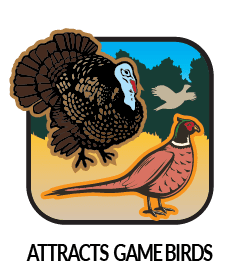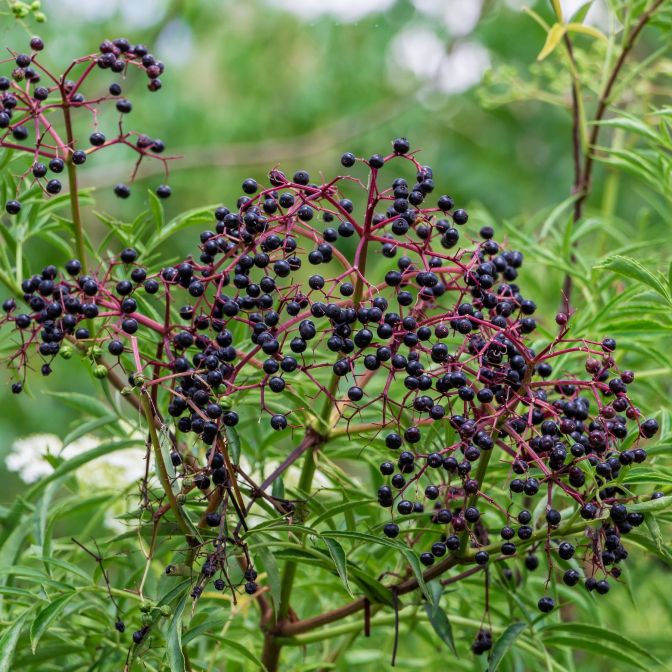American Elderberry
Plant Type: Dormant, bare-root
Zones: 3-9
Soil Type: Clay, Loamy & Sandy Soils
Site Selection: Full Sun, Partial Sun
Mature Height & Width: 10-15' Height and 10-15' Spread
Growth Rate: Fast - 24" or more per year once established
Moisture Requirements: Average to wet soils






American Elderberry
Sambucus canadensis
The American Elderberry is a large, spreading shrub that flowers in clumps of white early in the season. This shrub produces large clusters of small berries which are edible once autumn arrives. The ripened berries are great for making pie, wine and jam. This shrub is perfect for naturalizing wide open areas such as a farm field, and provides excellent cover for wildlife. This shrub will do very well in wetter areas and is commonly used for effective erosion control along rivers and streams. Consider planting another elderberry such as the Red Elderberry within 60' for even better pollination.
The American Elderberry is also known as the Common Elderberry, Mexican Elderberry or the Black Elder.
Important Note: Plant parts and raw, unripened berries are toxic to humans and animals, and are especially harmful to children. Only the blue-black, ripened berries should be picked and eaten or processed into other foods.
The American Elderberry is a great plant that grows in 45 of the 50 United States and the eastern two thirds of Canada. While not drought tolerant, this bush will grow in average soils. Plant this shrub in full sun for best results although it will tolerate part shade conditions. While you will likely get crops of berries when multiples of these shrubs are planted, a higher berry yield will occur if you plant another cultivar such as the Red Elderberry, which we also carry.
Common uses for the American Elderberry include:
- Ripened berries used for wine, jam and pie
- Naturalizing large, open spaces
- Erosion control along creeks and streams
- Privacy screens
- Good choice for lower story of a windbreak
- Great wildlife value
The American Elderberry produces flower clusters which are attractive to bees and butterflies. Game birds, squirrels, other rodents and several kinds of browsers also feed on the fruit or foliage of Elderberry. Bears love to eat the Elderberry fruits while deer, elk, and moose browse on the stems and foliage.
The Elderberries are important sources of summer food for many kinds of songbirds. For example, the Western Bluebird, Indigo Bunting, Common House Finch, Red-shafted Flicker, Ash-throated Flycatcher, Black-headed Grosbeak, Scrub Jay, Stellar Jay, Ruby-crowned Kinglet, Mockingbird, Red-breasted Nuthatch, Bullock’s Oriole, Hooded Oriole, Song Sparrow, White-crowned Sparrow, Western Tanager, California Thrasher, Russet-backed Thrush, Brown Towhee, Audubon Warbler, Cedar Waxwing, Lewis and Nuttall's Woodpecker, Wren-Tit, grouse, pheasant, and pigeons all eat Elderberries.
Product Questions
When we begin shipping, orders are sent out in the order that they were placed. However, we are mindful of orders placed in warmer and colder climates and typically ship them earlier or later on in our shipping process. We are also respectful of orders that have requested specific shipping weeks and work those in during the process accordingly.
Customers who place their order through our website have the ability to choose a window of time in which their order is delivered. This is located in the “Timing of Delivery” section on the checkout page. There, customers can choose a week in spring, based on your location and the anticipated item availability, and we will ship the order accordingly. When possible, we recommend using the default selection and allow us to ship your order at the most appropriate time (based on the harvest schedule and weather in your area). This should ensure that you do not receive your order too early in the event of a late snow melt. We do our best to monitor snow cover in all regions as we move into spring, and ship your trees or shrubs so that you do not receive them too early to plant.
If you choose to arrange the delivery week at the time of the order, it will supersede our discretion and your order will ship. We must be alerted at least one week prior to your chosen shipping week in order to make changes to your shipping schedule.





